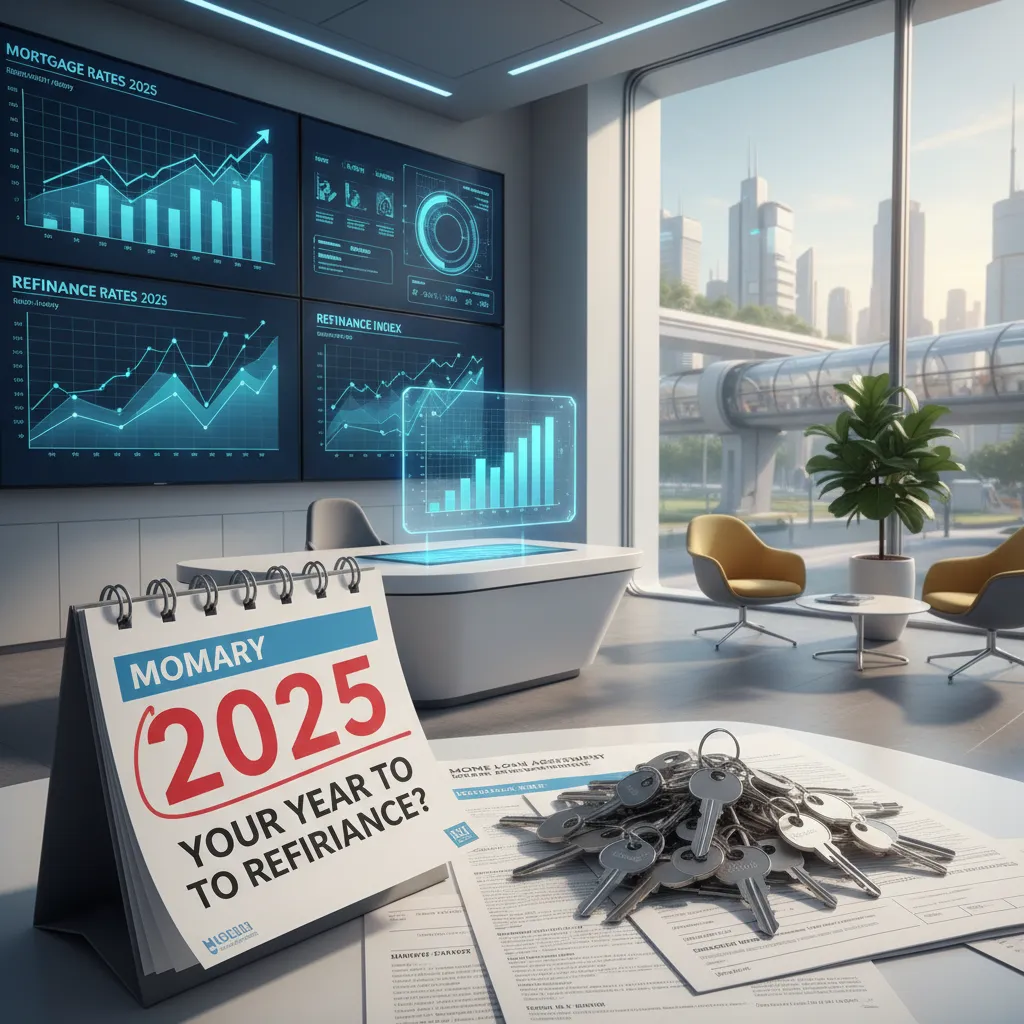I’ll never forget the day my neighbor Dave told me he was riding out high mortgage rates in 2023, as if hibernating through a storm. Little did he know that relief was around the corner. Fast-forward to 2025, and suddenly the landscape for mortgage rates is shifting—this time, in your favor. Why are rates slipping now, and is the hype justified? I set out to unravel the real story behind the dip, armed with more than a couple of coffee-fueled late-night research sessions. What I found might surprise you—and could save you thousands if you play your cards right.
The Wild Ride: Mortgage Rate History and the Story Behind the Trend
I’ll be honest—watching mortgage rate history unfold over the past few years has felt like riding a financial roller coaster without a safety harness. When rates shot to over 7% in early 2025, I experienced serious déjà vu from anyone who followed them through the chaotic 2020s. It was like watching the same movie twice, except this time we knew how the plot would twist.
By October 2025, something shifted. The average 30-year fixed mortgage settled into a more manageable range between 6.3% and 6.5%. While these numbers might seem high to anyone who remembers the pandemic-era lows of 2% and 3%, they actually feel like a relief when you consider where we’ve been. Unlike those historic lows that now seem like a distant dream, today’s rates represent genuine progress compared to the brutal 2022-2023 peaks.
The Emotional Toll of Mortgage Rate Volatility
Mortgage rate volatility isn’t just lines on a chart—it’s real life happening to real people. In my group chat, friends joke about needing a seatbelt for their home-owning journey. The emotional whiplash is genuine when you’re watching rates swing from month to month, wondering if you should refinance now or wait another quarter.
Take my cousin Carol, for example. She bought at 7.2% last year, convinced she couldn’t wait any longer. Now she’s practically ghosting her original lender, shopping around for a refinance at 6.3%. The difference in her monthly payment would be substantial—we’re talking about hundreds of dollars that could go toward her kids’ college fund instead of interest payments.
What’s Really Driving These Rate Swings
The rapid shifts we’ve experienced aren’t just because the Federal Reserve snaps their fingers and says “rates go up” or “rates go down.” The reality is much more complex. Federal Reserve rate cuts certainly influence the direction, but they’re just one piece of a massive puzzle that includes global markets, supply chain disruptions, and yes, even wild weather events that impact economic forecasts.
Inflation impact mortgage rates more directly than many homeowners realize. When inflation spikes, lenders demand higher returns to offset the risk of being paid back with less valuable dollars down the road. It’s basic economics, but the effects ripple through every homeowner’s monthly budget.
“Homeowners are breathing a cautious sigh of relief as rates inch downward. Timing is everything right now.” – Danielle Hale, Chief Economist, Realtor.com
The current environment feels different from previous cycles. We’re not dealing with just one economic factor—we’re navigating a perfect storm of post-pandemic recovery, geopolitical uncertainty, and shifting monetary policy. Everything from the Federal Reserve’s meeting minutes to supply chain snags in distant countries can impact the mortgage rates you’ll see when you walk into a lender’s office.
What strikes me most about this period is how quickly sentiment can shift. Six months ago, homeowners were bracing for rates to climb even higher. Today, there’s cautious optimism that we’ve seen the worst of it. This emotional journey reflects the very real financial impact these rate movements have on families across the country.

2. Decoding the Present: What’s Really Moving Mortgage Rates in 2025?
I’ll be honest—trying to predict mortgage rate trends used to feel like throwing darts blindfolded. I once tried to forecast rate changes based on headlines alone, and it turns out that’s like forecasting the weather without a Doppler radar. But after years of watching this market, I’ve learned that understanding the factors driving mortgage rates requires looking at the bigger picture.
The Federal Reserve’s Delicate Balance
The Federal Reserve is tiptoeing through inflation fears, and mortgage rates are following suit—if a little cautiously. The Fed’s cautious stance significantly influences the rate outlook we’re seeing in 2025. With Federal Reserve rate cuts being hinted at for later this year, there’s genuine optimism that we’ll see relief.
As Mark Fleming, Chief Economist at First American, puts it perfectly:
“The interplay between inflation control and Fed policy will make or break rate trends this year.”
This captures exactly what I’m seeing in the market. The Fed wants to support economic growth, but they’re still wrestling with inflation impact on mortgage rates. It’s a delicate dance, and mortgage rates are responding to every step.
The Complex Web of Economic Factors
Here’s what I’ve learned: there’s no single magic bullet when it comes to economic factors affecting mortgage rates. Instead, we’re dealing with a complex mix that includes:
- Economic slowdowns that are influencing Fed decisions
- Inflation’s stickiness that keeps everyone on edge
- International drama that sends unexpected ripples through our markets
- Housing supply dynamics that are finally shifting in our favor
Remember when a boat got stuck in the Suez Canal and somehow affected mortgage rates? That’s the kind of unexpected global headline that can move rates up or down overnight. Economic unpredictability isn’t just a buzzword—it’s a real force shaping today’s market.
Housing Supply: The Game Changer
One of the most encouraging developments I’m tracking is the gradual loosening of housing inventory. Data shows that housing inventory is up compared to the previous year, and this matters more than you might think. When supply and demand dynamics shift due to higher inventory and slower price growth, it creates breathing room in the market.
For homeowners looking to refinance, increased housing inventory means you have more options and slightly better negotiating power. Lenders are becoming more competitive, which translates to better terms for borrowers who are ready to act.
Why Timing Matters Right Now
The key factors I’m watching include recent economic slowdowns and those hints of Fed rate cuts around the corner. Monetary policy signals suggest rate cuts are pending by the end of the year, but here’s the catch—everyone else is watching the same signals.
What makes 2025 different is that all these factors are aligning simultaneously. The Fed’s cautious approach to inflation control, combined with improving housing supply and economic conditions that support lower rates, creates an environment we haven’t seen in years.
The wild card remains global headlines and volatile news that can move rates unexpectedly. But the underlying fundamentals—from Federal Reserve actions to slower house price growth—are pointing toward a more favorable rate environment for homeowners ready to refinance.
3. The Homeowner’s Dilemma: To Refi or Not To Refi?
I’ve been watching the mortgage refinancing landscape closely, and let me tell you—the activity is ramping up fast. Refinancing applications are on the rise, and homeowners across the country are asking themselves the same question: is it worth jumping on this bandwagon today?
The promise of lower monthly mortgage payments sounds incredibly appealing, especially after years of elevated rates. But here’s what I’ve learned from covering this industry: early birds consistently snag the best mortgage terms 2025 has to offer before the masses jump in. It’s a simple supply and demand equation—when everyone wants the same thing, lenders get pickier and processes slow down.
Learning from Past Refinancing Rushes
I remember racing to refinance back in the late 2010s and ended up buried behind a paperwork mountain when demand exploded. That experience taught me a valuable lesson: move before the crowd. Right now, we’re seeing the early stages of what could become another refinancing frenzy, and those who act quickly will have significant advantages.
As Sam Khater, Chief Economist at Freddie Mac, recently noted:
“If you expect further rate cuts, today’s rates may still offer significant savings compared to recent highs.”
This insight highlights why timing matters so much in the current market environment.
Beyond Payment Reduction: Debt Consolidation Refinancing
Debt consolidation refinancing is trending heavily right now, especially among homeowners juggling credit card balances or student loans. I’ve seen families transform their financial situations by rolling high-interest debt into their mortgage at today’s lower rates. However, this strategy requires careful consideration of your long-term financial goals.
Here’s what makes debt consolidation appealing through refinancing:
- Lower interest rates compared to credit cards
- Single monthly payment instead of multiple bills
- Potential tax benefits on mortgage interest
- Extended repayment terms to reduce monthly burden
Home Equity: Tool vs. Magic Wand
Many homeowners view their home equity as a magic solution to financial challenges. While tapping into equity through a refinance mortgage application can provide substantial funds, it’s important to remember that your home secures this debt. I always recommend weighing refinancing fees against long-term goals before making this decision.
The Rush Is Already Beginning
Lenders are reporting longer wait times as application numbers grow. The average time to process mortgage refinance applications is increasing as demand surges, which means delays are becoming more common. This creates a clear advantage for homeowners who start their applications now rather than waiting for rates to drop further.
The data supports this trend—refinancing applications are up significantly versus 2024 levels, and early action locks in better mortgage rates amid this surging demand. If you’re considering a refinance for any reason—whether to lower payments, consolidate debt, or access equity—the window for optimal timing is narrowing as more homeowners recognize the opportunity.
The question isn’t whether refinancing activity will increase; it’s whether you’ll position yourself ahead of the wave or get caught in the undertow of increased demand and longer processing times.

4. Creative Plays: Debt Consolidation, Home Equity & Unconventional Strategies
As mortgage rates show promising signs of decline in 2025, I’m witnessing a fascinating shift in how homeowners approach refinancing. It’s not just about lowering monthly payments anymore—creative refinancing and home equity strategies are becoming more mainstream, and the possibilities are genuinely exciting.
Debt Consolidation Refinancing: Your Financial Lifeline
Debt consolidation refinancing has become a heart-stopper for those crushed by high-interest debt. I’ve seen homeowners trading credit card balances at 24% interest for mortgage rates in the 6-7% range. The math is compelling: if you’re carrying $50,000 in various debts, consolidating through a cash-out refinance could save you hundreds monthly while simplifying your financial life into one payment.
The key is timing this right. With rates trending downward, those who start their applications now position themselves to capture even better terms as 2025 progresses.
Home Equity Loans Advantages: Beyond Traditional Uses
Home equity loans advantages extend far beyond emergency funds. I’m seeing both cautious and creative borrowers leverage their equity for everything from dream kitchen renovations to wiping out student loans at significantly lower interest rates. Borrowers are leveraging equity for everything from renovations to debt payoff, treating their homes as financial tools rather than just shelter.
Would I ever use home equity to finance a cross-country road trip? Probably not—but it’s tempting when rates drop! The reality is that some homeowners are getting creative, using equity for investment opportunities or major life transitions that traditional loans wouldn’t cover.
Advanced Strategies: ARMs and Mortgage Points
Adjustable rate mortgages and mortgage points offer ways to finesse the numbers even further in today’s market. ARMs can provide initial savings for borrowers who plan to move or refinance again within a few years. The current spread between fixed and adjustable rates creates opportunities for maximizing savings mortgage refinancing.
However, don’t get caught in the fine print. ARMs require careful consideration of rate adjustment caps and your long-term financial plans.
The Investor’s Playground
Some unique use cases are emerging where homeowners almost treat home equity as an investor’s playground. I’ve encountered borrowers using equity to:
- Purchase investment properties
- Fund business ventures
- Invest in stock market opportunities
- Finance children’s education expenses
“The smartest borrowers are those finding new ways to leverage home equity while rates are moderate.” – Selma Hepp, Chief Economist, CoreLogic
This trend reflects a broader understanding that home equity represents more than just emergency funds—it’s become a strategic financial resource.
The Reality Check
Every strategy has tradeoffs, and I can’t stress this enough: consult a professional before turning your home into an ATM. Your home serves as collateral for these loans, meaning you’re risking your shelter for financial leverage. The recent increase in home equity loan applications shows growing confidence, but smart borrowers understand both the opportunities and risks.
The current mortgage environment offers unprecedented flexibility for homeowners willing to think creatively about their equity. Whether you’re consolidating debt, funding major projects, or exploring investment opportunities, 2025’s shifting rate landscape creates options that weren’t available just months ago.
5. Crystal Ball Time: Mortgage Rate Predictions and What’s Next
I’ve been watching the tea leaves, and the mortgage rate predictions for the rest of 2025 are looking promising for homeowners. Let me share what I’m seeing in the crystal ball—and why timing matters more than ever.
Current Mortgage Rate Predictions Through 2025
Experts predict 30-year fixed mortgage rates will finish 2025 between 6.3% and 6.7%. While these numbers might not make you jump for joy, they represent real savings compared to the peak rates we’ve endured. The mortgage rate forecast shows we’re moving in the right direction, even if we’re not sprinting there.
Here’s what I’m tracking: forecasts hover in the mid-6% range through the end of 2025, which means we’re looking at a gradual decline rather than a dramatic drop. This steady downward trend creates opportunities for savvy homeowners who position themselves early.
The Federal Reserve Factor
The next Federal Reserve rate cut could be a tipping point, sending a wave of applicants to lenders almost overnight. I’ve watched this pattern before—when the Fed signals easier monetary policy, refinance applications surge within days. The smart money is getting applications ready now, before that flood hits.
If I had to wager, I’d say rates won’t revisit pandemic-era lows for a long time, but there’s real value in the decline we’re seeing now. Those 2% and 3% rates were an anomaly born from economic crisis. Today’s trajectory toward the mid-6% range represents a more sustainable normal.
Best Mortgage Terms 2025: The Early Bird Advantage
Homeowners who act before the crowd will likely see the biggest wins in terms of savings and loan flexibility. As Odeta Kushi, Deputy Chief Economist at First American puts it:
“Those who prepare now are poised to capture the best financial outcomes when rates bottom out.”
The best financial outcomes go to early, well-prepared applicants. I’m already seeing this play out—lenders are starting to stretch their processing times as application volume increases. The best mortgage terms 2025 will likely go to borrowers who beat the rush.
Timing the Market vs. Taking Action
Nobody can outsmart the market perfectly—sometimes you just have to leap when the water’s warm, not wait for a whirlpool. I’ve seen too many homeowners wait for the “perfect” rate while missing out on meaningful savings available right now.
Here’s my reality check: even if rates drop another half percentage point by year-end, the difference between acting now versus waiting could be minimal compared to the risk of getting stuck in processing delays when everyone else decides to refinance.
What to Watch Beyond Rates
Pro tip: Watch not just rates but lender processing times—they’re already stretching as the pool of applicants grows. I’m tracking refinance lending delays that are increasing as activity spikes. This means your window for quick processing is narrowing.
The mortgage landscape is shifting toward opportunity, but that opportunity comes with competition. The homeowners who recognize this trend early and act decisively will capture the most value from 2025’s rate environment.

6. Reality Check: Pitfalls, Misconceptions, and the Human Side of Mortgage Maneuvering
I’ve watched countless homeowners stumble over the same obstacles when chasing mortgage rate changes impact opportunities. Even the savviest borrowers get tripped up by fine print, unexpected fees, or overly optimistic assumptions about their refinancing journey.
The Neighbor Comparison Trap
Here’s a scenario I see repeatedly: someone hears their neighbor locked in a 6% rate and assumes they’ll get the same deal. This “my neighbor got it, so will I” mentality ignores crucial differences in credit scores, debt-to-income ratios, and loan amounts. Each borrower’s financial fingerprint is unique—never skip doing your own math!
I wish I had a nickel for every time someone called me excited about refinancing, only to discover they hadn’t calculated closing costs. These fees can range from 2-5% of your loan amount, turning what seemed like savings into a financial setback.
Hidden Costs Behind the Best Mortgage Terms 2025
When hunting for the best mortgage terms 2025 has to offer, borrowers often fall for headline rates without reading the details. Lower rates aren’t always best if they come with costly prepayment penalties or expensive mortgage points. Sometimes paying slightly higher interest saves thousands in upfront costs.
“Read the fine print and don’t get seduced by headlines—custom fit beats off-the-rack every time.” – Greg McBride, Chief Financial Analyst, Bankrate
The Emotional Rollercoaster
Interpersonal friction around mortgage decisions is real. Hearing about friends’ lower rates can trigger both FOMO and regret—I’ve been there myself. These emotional responses often lead to hasty decisions that ignore personal financial circumstances.
Think about it this way: imagine if mortgage applications worked like airline tickets. Would you gamble on last-minute deals or book months in advance when you see favorable conditions? Most smart travelers book early when they spot good prices, yet mortgage shoppers often wait for the “perfect” moment that may never come.
Common Misconceptions That Cost Money
Here are the biggest misconceptions I encounter:
- Advertised rates equal approved rates – Your actual rate depends on your specific financial profile
- Timing the market perfectly – Waiting for rock-bottom rates often means missing good opportunities
- Refinancing is always worth it – Break-even calculations must include ALL costs, not just interest savings
- All lenders offer the same deal – Shopping around can save thousands, but comparing apples-to-apples is crucial
The Human Element
Fine print and emotional decisions can derail even well-researched refinancing plans. I’ve seen borrowers get so caught up in rate hunting that they ignore application deadlines, miss document requirements, or choose lenders based solely on initial quotes rather than actual service quality.
The key is balancing informed decision-making with realistic expectations. Yes, mortgage rate changes impact your potential savings, but your individual circumstances matter more than market headlines. Focus on your break-even timeline, total costs, and long-term financial goals rather than chasing the lowest possible rate.
Remember, successful refinancing isn’t about getting the same deal as your neighbor—it’s about finding the right fit for your unique situation while avoiding the pitfalls that trip up even experienced homeowners.
7. Conclusion: Timing, Preparation, and Where the Smart Money Moves Next
As I reflect on everything we’ve covered about maximizing savings mortgage refinancing in 2025, one truth stands out: this market rewards the prepared. We’re entering a unique window where rates are trending downward, but the opportunity won’t last forever, and it certainly won’t wait for those who hesitate.
2025’s mortgage market demands both speed and reflection. You need to act quickly when opportunities arise, but you also need to plan carefully. I’ve learned this lesson the hard way. After missing the last big refinance window in 2020—watching rates plummet while I sat on the sidelines debating whether to move—I swore I’d never wait on the fence again.
Those who prepare now are positioning themselves for the best mortgage terms 2025 will offer. This means gathering your paperwork today, comparing lender offers, and understanding your current financial position. When rates drop and demand surges, lenders’ processing times are projected to increase significantly. The borrowers who already have their documentation ready and applications started will be first in line for the best deals.
“Opportunity is there for those ready to move—don’t be the last one in line.” – Jeff Tucker, Senior Economist, Zillow
Ongoing monitoring pays dividends in this volatile environment. Mortgage rates can shift with little warning, influenced by economic data releases, Federal Reserve decisions, and market sentiment. Setting up rate alerts and staying updated through reliable sources isn’t just smart—it’s essential. The difference between catching a rate at 6.2% versus 6.8% could mean thousands in savings over your loan’s lifetime.
Even if you’re not ready to pull the trigger on mortgage refinancing today, preparation is power. In a few months, when rates potentially drop further, the line grows much longer. Lenders become pickier about credit scores and debt-to-income ratios. The borrowers who prepared early get the premium treatment and best terms.
Here’s how you win next time: Start gathering your financial documents now. Request recent pay stubs, tax returns, and bank statements. Check your credit score and address any issues you find. Research multiple lenders and understand their requirements. Calculate your break-even point so you know exactly when refinancing makes sense for your situation.
The research consistently shows that combining readiness with strategic action ensures the best outcomes. This isn’t about rushing into a decision you’re not prepared for—it’s about being ready when the right opportunity presents itself.
The smart money isn’t waiting to see what happens next. It’s positioning itself now for the opportunities that 2025 will bring. Whether you’re looking to lower your monthly payment, tap into home equity, or consolidate debt, the groundwork you lay today determines your success tomorrow.
Don’t let this refinancing cycle pass you by. The mortgage market is showing clear signs of shifting in borrowers’ favor, but only for those ready to act. Start your preparation today, and when rates hit your target, you’ll be ready to move while others are still scrambling to get organized.
TL;DR: Mortgage rates are easing and could head lower through 2025, presenting a prime window for homeowners to refinance or consolidate debt. Moving early could help you secure the best terms before demand (and lender lines) swell. The real winners? Those who act before the crowd catches on.

